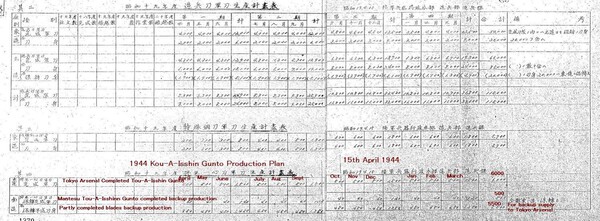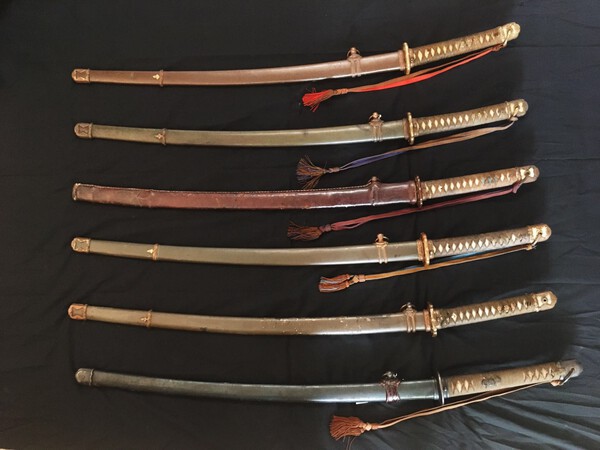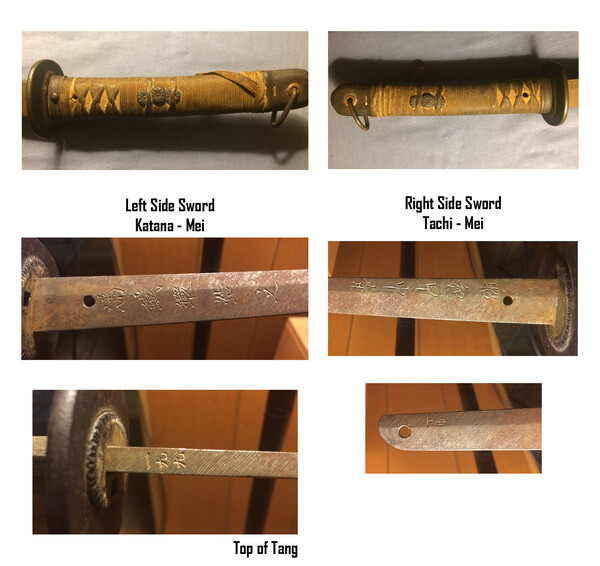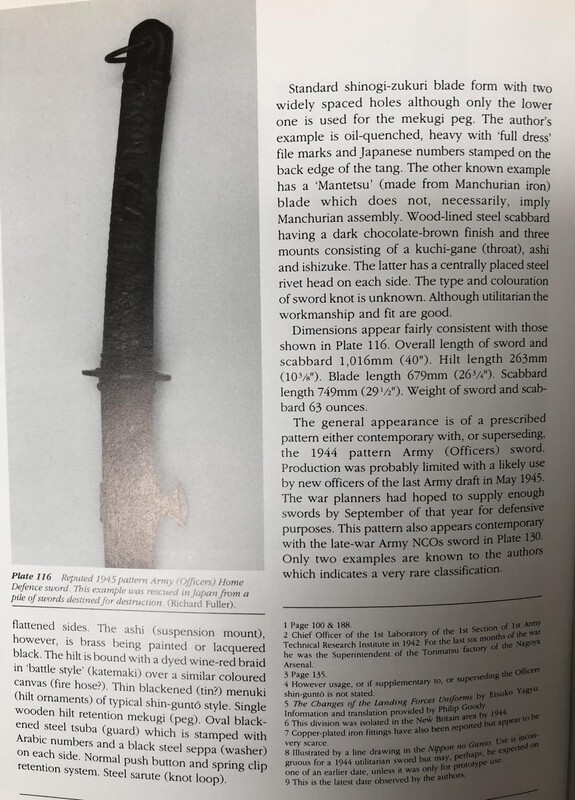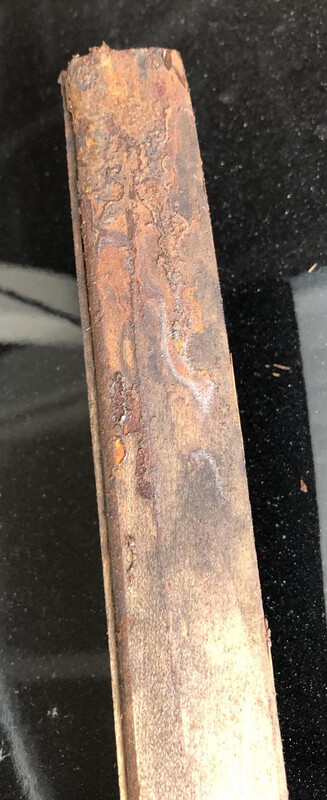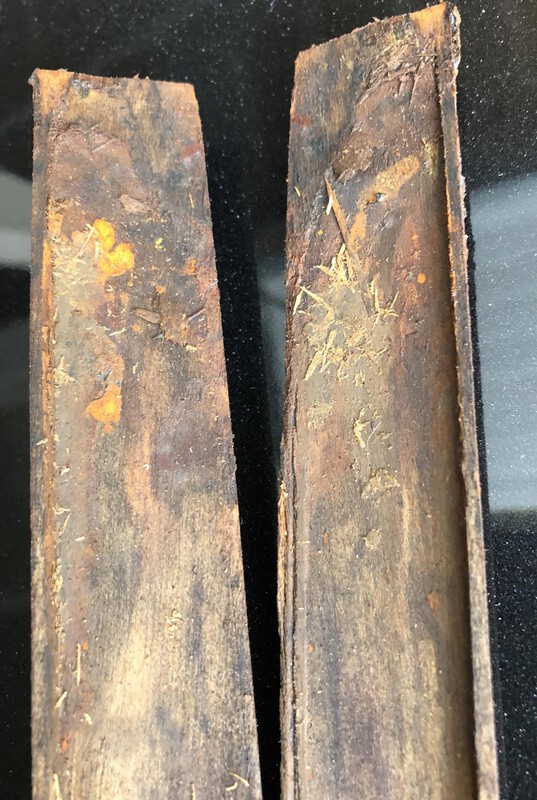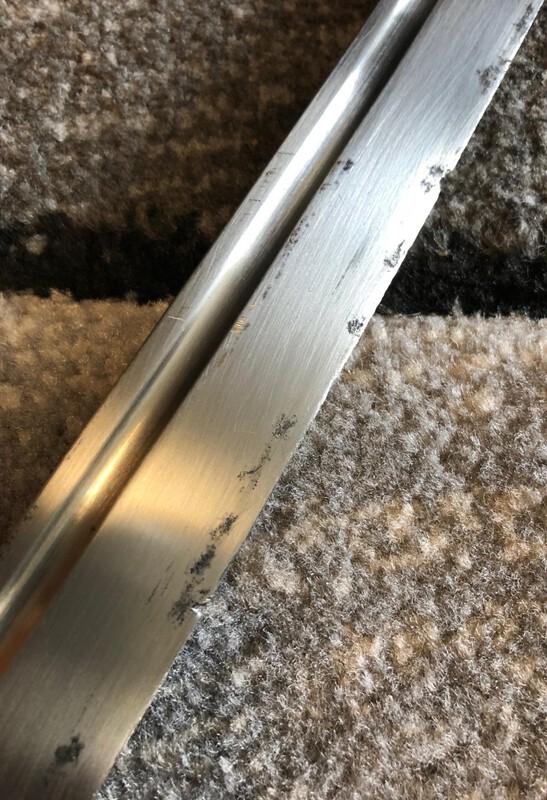-
Posts
13,018 -
Joined
-
Last visited
-
Days Won
155
Content Type
Profiles
Forums
Events
Store
Downloads
Gallery
Everything posted by Bruce Pennington
-

1945 Pattern Officers Sword
Bruce Pennington replied to IJASWORDS's topic in Military Swords of Japan
Good point, Neil. That was probably the last of the model made by Tokyo shops. Your special model was likely something designed and produced by a shop in Manchuria. The type of orders Nick showed in his example, likely freed the Manchurian koshirae makers to create their own design. And so far, it seems it was created for the Mantetsu operation. Ohmura's page pointed out that we're not likely to ever find design specs or order documents due to the Soviet invasion of the area at the end of the war. So, if it were ever proposed to Army HQ as a new design, we might never find out. Nick's point about the Rinji Seishiki is that, even it, was not meant as a permanent model. It was designed to improve the "exterior" of the Type 98, and was supposed to be temporary until changes were incorporated, or rejected. For the Manchurian shop to come up with their own improvements would not be a surprise to me. The main point, as of yet, is there is no records to confirm or deny any of this. So, as collectors, we will have to come up with something to call it, for simple communication purposes. -
Dang, that's a fabulous resource, Stegel. Can't thank or praise you enough for creating it.
-

Attention Mantetsu Owners: A Survey
Bruce Pennington replied to Bruce Pennington's topic in Military Swords of Japan
Well, that shows that not all of them carry Mantetsu blades. He doesn’t show the nakago on that one, but the hamon isn’t a Mantetsu. -

Attention Mantetsu Owners: A Survey
Bruce Pennington replied to Bruce Pennington's topic in Military Swords of Japan
Ok, thanks Thomas! I felt I might be misinterpreting the English translations of those lines. As to the late-war fittings all having Mantetsu blades, Nick's response is here: http://www.warrelics.eu/forum/Japanese-militaria/1945-rinji-seishiki-icu-ventilator-762330/ I felt the issue was relevant to both the Mantetsu discussion as well as Neil's original thread on these fittings, so I've posted the links on both threads. -

1945 Pattern Officers Sword
Bruce Pennington replied to IJASWORDS's topic in Military Swords of Japan
At this point, we could at least call it the "Manchurian Model". And since quite a few have '44 blades, the "1945" part of the name doesn't do it justice. -

1945 Pattern Officers Sword
Bruce Pennington replied to IJASWORDS's topic in Military Swords of Japan
I posed the question to Nick Komiya, at Warrelics, if he had any data, or documents, describing the "Home Defense model" sword mentioned in several reference books. His response can be found here: http://www.warrelics.eu/forum/Japanese-militaria/1945-rinji-seishiki-icu-ventilator-762330/ Realizing that some have trouble with links, the majority of his evaluation is here: "There is no chance that such a sword was made for civil defense units. Core members of civil defense were policemen and firefighters, but such personnel simply could not get swords, due to wartime shortages. This shortage got to the point of prefectural police chiefs receiving a nationwide memo dated 27th February 1945 saying that though huge efforts were being made to secure a supply of badly needed swords, no magic solution was in sight and that the only immediate remedy was to ask retired police and fire brigade members to hand in their swords for use by incumbents, should they still have them. On the civilian front, the standard weapon of choice for Homeland Defense was the stereotype of sharpened bamboo poles, and there certainly was no plan nor intention to arm civilians with swords. What Bruce is calling a Homeland Defense model can only be a last ditch effort to continue the Rinji Seishiki effort. As I already explained here, the heavy bombings of 1944 basically killed off the sword industry by spring of 1945. Manufacturing within Japan was in the process of evacuation and relocation to a remote area outside the normal target areas. Reflecting this huge disruption to production efforts, two new weapon names suddenly appeared in the production volume plans for 1945 as published in May of that year. Those weapon names were 簡易銃剣 (simplified bayonet) and 簡易小銃 (simplified rifle). In the remarks column, the spreadsheet says of the bayonet “Without restricting the material or design, it should be outright simple, just enough to stab and hack with” Production planned for 1945 was as many as 1,200 thousand units. Remarks for the rifle said “Enhanced independence of the production locale”. When spelled out fully, that would mean “to get things done under one roof as much as possible without relying on parts suppliers all scattered around”. They had planned to put together 15,000 of these rifles. Both these simplified weapons were officially approved for production on 14th May 1945. When mainland production was in such a stage of grasping at straws, continental facilities like Jinsen and Nanman were safe havens away from all the bombing, but unlike before, they no longer had the luxury of job distribution possibilities with the mainland and had to produce everything locally, lock, stock and barrel. I am not enough of a sword fan to know how Mantetsu split jobs with mainland companies, but if they had been relying on Japan for the Koshirae, the tide of the times would have required all that to be Manchurian sourced as well. If they said of the bayonet "Never mind what it looks like or what it's made of, so long as it stabs and hacks", a Mantetsu blade with duct tape as Tsukamaki would have easily made the grade. Is that to be regarded as a new model? It would be more like the the Rinji Seishiki taking its last free breath before going on the ventilator." -

Attention Mantetsu Owners: A Survey
Bruce Pennington replied to Bruce Pennington's topic in Military Swords of Japan
So, is:"Mantetsu Koa Isshin Gunto completed back-up production....500" and "Partly completed blades back-up production ......................5,500" a breakdown of the 6,000 "Tokyo completed Koa Isshin"? -

Attention Mantetsu Owners: A Survey
Bruce Pennington replied to Bruce Pennington's topic in Military Swords of Japan
Just got word back from Richard Fuller and he doesn't own that one. He does have a '41 Koa, NE 414, that I didn't have though! Thomas, My real question is about the production numbers. After re-reading the chart, I feel like it's saying that SMR was producing 1,000 blades per month, not 500. Am I reading this right? -

Attention Mantetsu Owners: A Survey
Bruce Pennington replied to Bruce Pennington's topic in Military Swords of Japan
I've been thinking on this lately. In light of Nick Komiya's '44 production chart, I don't see how that is possible. It shows that SMR was making 500 blades/month = 6,000/yr. It also shows that all 6,000 were to go to the Tokyo Arsenal. If this happened (and we know things didn't always go according to orders), but if it were fulfilled, where did the blades come from to go to Nanman for finishing? I suppose Tokyo arsenal could have contracted with Nanman to do the finishing and had them sent to Nanman. But we're getting seriously into speculation-land. Update: After rechecking the chart, Thomas, I REALLY need your Japanese skills to clarify this thing!!! One line says "Tokyo completed Koa Isshin Gunto .....6,000" The next line says "Mantetsu Koa Isshin Gunto completed back-up production....500" The next: "Partly completed blades back-up production ......................5,500" With Nick's note at the end "For back-up supply to Tokyo Arsenal" I had assumed the 500 + 5,500 accounted for the 6,000 above but that is NOT what it says, as the first line, of 6,000 is "Tokyo completed Koa Isshin"! If I'm seeing this right, there were 6,500 Koa Isshin made in '44 (6,000 Tokyo, 500 Mantetsu) and an ADDITIONAL 5,500 unfinished blades for "Tokyo Arsenal back-up" (which COULD have been sent to Nanman for finishing?). This is why I need your skill, Thomas. What is this chart really saying? Because if I am now reading this right, then the SMR factory cranked out 12,000 blades in '44 - 1,000/month - not the 400-500 were have always read about. As a final note, of the 15 '44 blades we have record of, only 4 were Koa's. The majority are NOT Koa Isshin. You'd think with these proportions we'd see more Koa's. Yet, 15 is not a very good sampling to make such a call, I realize. -

Attention Mantetsu Owners: A Survey
Bruce Pennington replied to Bruce Pennington's topic in Military Swords of Japan
Went back over the files - I have 6 '44s in Rinji fittings and they are ALL Neil's tyle fittings! As mentioned in a earlier post, 2 other '44s have the double ana (made for Rinji) but mounted in standard 98 fittings. There are other '44s in standard fittings, but they don't have the double ana. All blades observed in the "SE" serial group seem to have been made for the Rinji fittings, and all observed are of Neil's style. Here are two others: Trystan's: And one from the web: This one (SE 1310) has leather saya cover: -

Genuine Kyu Gunto Saya
Bruce Pennington replied to TheGermanBastard's topic in Military Swords of Japan
Calling Hamish!!!! -

Attention Mantetsu Owners: A Survey
Bruce Pennington replied to Bruce Pennington's topic in Military Swords of Japan
Neil, Without digging through my photos, do you know if ALL Mantetsu in '44, '45 in non-standard 98 fittings are in these unique style? In other words - are there '44/'45 blades in "regular" Rinji fittings? -
Wow, so looks like all 3 on this thread so far are 19s then. Thanks for the tips!
-
Well shoot. I've told a couple of guys, now, the wrong poop on that! I re-read that section from Dawson, and see that he says that Type 8 lower ashi were not removable, while Type 19 lowere ashi were removable (though "some" weren't removable), and some later 19s (1930s) came with onely 1 ashi. He also stated the main difference in 8s and 19s were in material specs, but didn't say what that means. How do you distinguish, then, between an 8 and 19?
-

Attention Mantetsu Owners: A Survey
Bruce Pennington replied to Bruce Pennington's topic in Military Swords of Japan
Neil, You may very well be right. I posted the following request to Nick Komiya: "Komiya-san, I'm wondering if you've done any digging into the topic of the Homeland Defense efforts at the end of the war? The reason I ask is there is a version of Officer gunto that seems to have appeared in 1945, similar to the Rinji Seishiki model, yet distinctly different. Both Fuller and Dawson opined that it was a Homeland Defense model, yet all known examples have Mantetsu blades in them. Rapid/mass produced Home Defense items don't tend to have such high-end characteristics. So, I'm wondering if there were any mil specs put out for swords in 1945 for Home Defense? If so, we can compare these gunto to the specs. If not, we are left with speculation for the time being. Respectfully, Bruce Pennington" -

Attention Mantetsu Owners: A Survey
Bruce Pennington replied to Bruce Pennington's topic in Military Swords of Japan
Neil, Lacking any documentary info, I would personally lean towards calling these a official variation of the RS (Rinji Sheishiki), just as there are variations of the Type 95. There are too many similarities to the RS. Like the steel tsuba was to the sculpted tsuba (95s), I would consider these variants simplifications to the "fancy" original plan. But, in the end, you could very well be correct. Hope we find out some day. Maybe we can nudge Nick K. in that direction and get some papers on it! -

Attention Mantetsu Owners: A Survey
Bruce Pennington replied to Bruce Pennington's topic in Military Swords of Japan
Thomas reminded me of Fuller's discussion of these. On pg 82, he discusses just such a gunto as yours, Neil, and shows a picture. He was aware of 2, one mumei and the other Mantetsu mei, both with serial numbers. He was the one speculating that they were Home Defense, but doesn't name his source or reason. I also like your link, Thomas, to Doug's example and his observation that he has ONLY seen Mantetsu blades in these. -

Attention Mantetsu Owners: A Survey
Bruce Pennington replied to Bruce Pennington's topic in Military Swords of Japan
I checked a few and all the M/W stamps were on the date side, yes. -
That’s a very nice piece Alex, congrats. It amazes me too when I see immaculate gunto. There is a chance this was an early 19, as they produced some with the double Ashi, before they went to single ashi, but odds are in favor that this was a Type 8. All of them had the double, and that would make it even older!
-

An Example of Water Damage From a Wet Saya
Bruce Pennington replied to Bruce Pennington's topic in Military Swords of Japan
Thanks Dave & Barry, didn't think of that! I'll be sure to rub the wood down after dry to make sure it's free of grit. JP, the 95 saya has just the one screw to remove the throat. Most of the time, the wood slides right out, but mine was wet and stuck. I had to invert my saya and tap the opening on a piece of wood on my workbench to bring the wood down to the edge. The wood can be real brittle sometimes, but this set was thick and strong (maybe because it was wet), so I was able to pinch one side between 2 flat-head screw drivers and pull slowly. Chris, nice tips, thanks! -

Show Us Your High Class Gunto
Bruce Pennington replied to lonely panet's topic in Military Swords of Japan
That guy had a cushy job during the war! Not even a door-dink on the saya! -
Bought this Type 95 at auction (same group I got bit by with the fake 98). The blade has permanent black stains. When I asked Neil about it, he said it's likely tanin stains coming out of the wooden liner. So I got curious and opened up the saya and removed the liner. Sure enough, the wood was wet to the touch. There were rust stains IN THE WOOD! The end of the liner was the worst, and you could see that water (don't know if pooled oils could do this?) had settled to the bottom of the saya, soaking the wood, moistening the tanins, which then stained the steel. I've lightly sanded the corroded portions of the liner and am currently drying the liner as well as the empty saya. Thought I'd share this, along with pics for everyone else in case you have gunto sayas that may be damaging your blades.
-
"And THAT ..... is the REST of the story" as a famous broadcaster used to say!
-

Attention Mantetsu Owners: A Survey
Bruce Pennington replied to Bruce Pennington's topic in Military Swords of Japan
I see. The angle of the original photo made the blossom look different. But it is flatter than the earlier version. I'm just not familiar with that style ashi and didn't realize it's the style of the late-war Rinji fittings. Thanks Neil!



